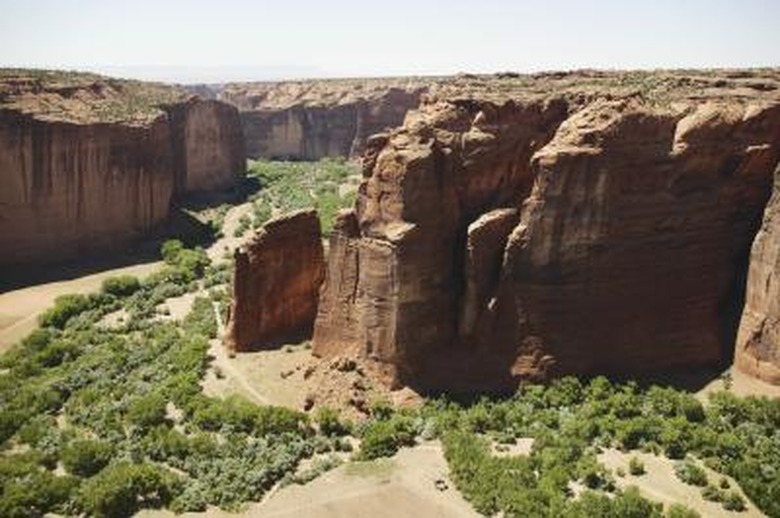Temperature Of Earth's Lithosphere
Plate tectonic theory teaches that the Earth is divided into layers called crust, mantle and core, with continents and ocean basins made of different kinds of crust. The surface is made up of gigantic plates that move about very slowly; however, this movement does not stop at the bottom of the crust. Instead, it stops at a zone within the mantle. The rocks above this zone, including the crust and the upper part of the mantle, are called lithosphere.
Layers of the Earth
Layers of the Earth
The Earth is made up of four main layers. At the surface is a thin, cool layer of highly varied rocks that make up the crust, with an average thickness of about 30 kilometers (18.6 miles). The mantle forms a layer of silicate minerals about 2,900 kilometers (1,800 miles) thick beneath the crust. At the center is the core, which is actually two layers: an outer core of molten metal about 2,250 kilometers (1,400 miles) thick and a solid metal core with a radius of about 1,220 kilometers (800 miles). Both solid and liquid core are mostly iron plus nickel, sulfur and small amounts of other elements.
The mantle accounts for about 84 percent of the Earth's volume, and the crust makes up another 1 percent. The core occupies the other 15 percent.
Upper Mantle, Lithosphere and Asthenosphere
Upper Mantle, Lithosphere and Asthenosphere
Earth scientists divide the mantle into upper and lower mantle, placing the boundary at about 670 kilometers (416 miles) deep. They divide the uppermost few tens of kilometers of the mantle into two parts based on how the rocks behave when stress is applied, meaning when they are pushed or pulled. The very topmost layer of the mantle tends to break when stress is applied, while the layer just beneath it is soft enough to bend. Breaking is called "brittle" deformation: A breaking pencil is brittle deformation. The lower layer reacts to stress with "ductile" or "plastic" deformation, like a tube of toothpaste or a lump of modeling clay.
Scientists call the part of the upper mantle that displays plastic deformation the asthenosphere and call the combination of crust and shallower, more brittle mantle the lithosphere. The boundary between the two layers ranges from a few kilometers below the surface at oceanic spreading centers to about 70 kilometers (44 miles) under the centers of continents.
Temperature of the Earth's Interior
Temperature of the Earth's Interior
Scientists estimate that the solid nickel-iron alloy at the center of the Earth has a temperature in the range of 5,000 to 7,000 degrees Celsius (about 9,000 to 13,000 degrees Fahrenheit). The outer, liquid core is cooler; but the bottom of the mantle is still subjected to temperatures of around 4,000 to 5,000 degrees Celsius (7,200 to 9,000 degrees Fahrenheit). This temperature is more than hot enough to melt the mantle rocks, but the very high pressures keep them from turning to liquid. Instead, the hottest mantle rocks rise very, very slowly toward the surface. At the same time, the coolest rocks in the upper mantle sink toward the core. This constant motion creates super-slow currents circulating within the mantle.
Asthenosphere, Lithosphere and Plate Tectonics
Asthenosphere, Lithosphere and Plate Tectonics
Rocks in the lithosphere remain solid, floating on top of the mushy or partially melted rocks in the asthenosphere. The bottoms of the tectonic plates are at the boundary between asthenosphere and lithosphere, not the bottom of the crust, and it is the plastic nature of the asthenosphere that allows the tectonic plates to move.
Temperature of the Lithosphere
Temperature of the Lithosphere
The lithosphere does not have a specific temperature. Instead, the temperature varies with depth and location. At the surface, the temperature is similar to the average air temperature at the location. The temperature increases with depth down to the top of the asthenosphere, where the temperature is about 1,280 degrees Celsius (2,336 degrees Fahrenheit).
The rate of change in temperature with depth is called the geothermal gradient. The gradient is higher — temperature increases more rapidly with depth — in ocean basins where the lithosphere is thin. Over continents, the gradient is low because the crust and lithosphere are thick.
References
- Windows to the Universe: The Earth's Crust, Lithosphere and Asthenosphere
- U.S. Geological Survey: The Interior of the Earth: Eugene C. Robinson
- National Geographic Education: Mantle
- Earlham University: The Marianas Trench
- Scripps Institute of Oceanography: Indirect Observation: Temperatures Inside the Earth
Cite This Article
MLA
O'Donahue, Kelvin. "Temperature Of Earth's Lithosphere" sciencing.com, https://www.sciencing.com/temperature-earths-lithosphere-23211/. 24 April 2017.
APA
O'Donahue, Kelvin. (2017, April 24). Temperature Of Earth's Lithosphere. sciencing.com. Retrieved from https://www.sciencing.com/temperature-earths-lithosphere-23211/
Chicago
O'Donahue, Kelvin. Temperature Of Earth's Lithosphere last modified March 24, 2022. https://www.sciencing.com/temperature-earths-lithosphere-23211/
